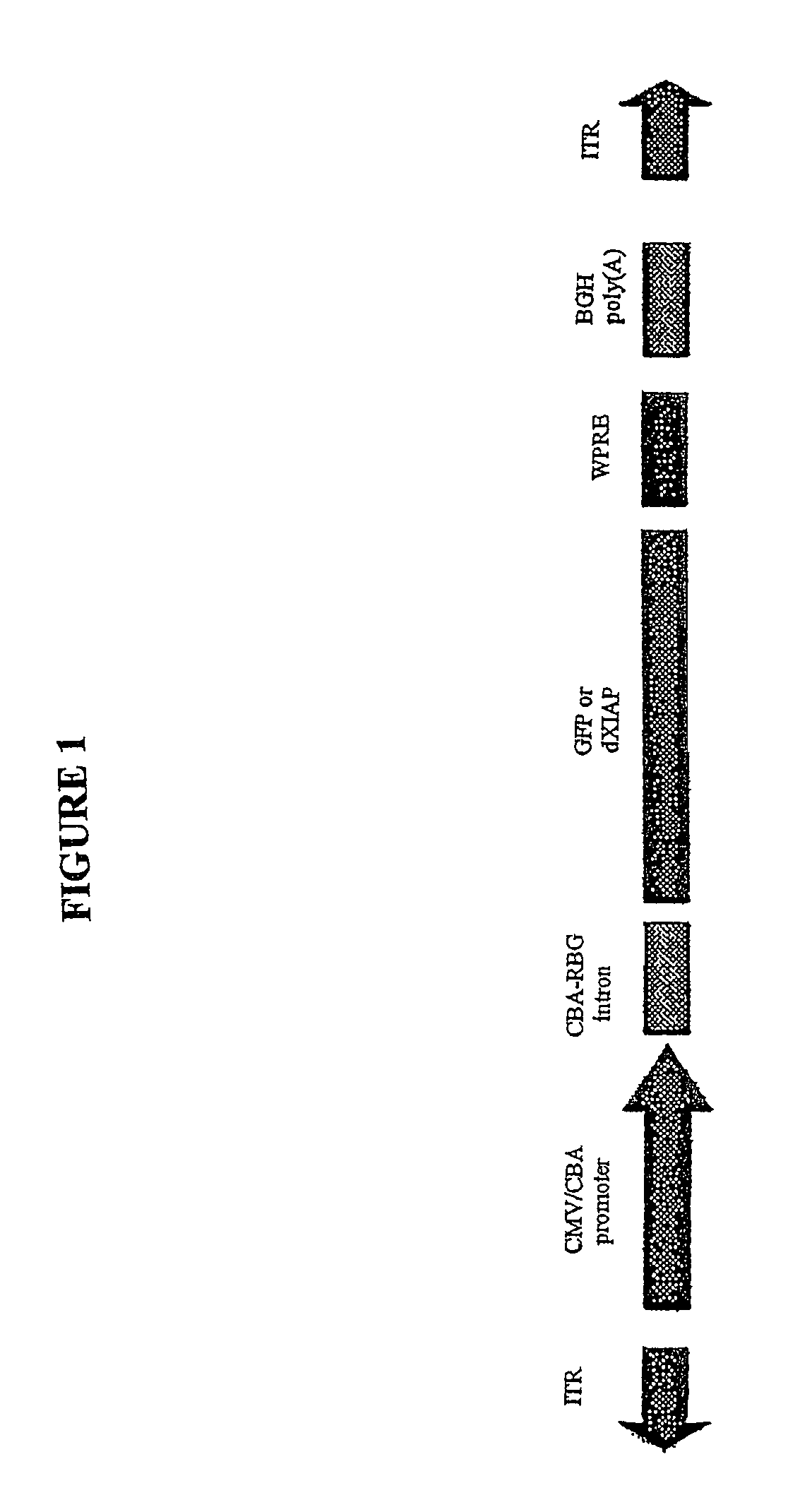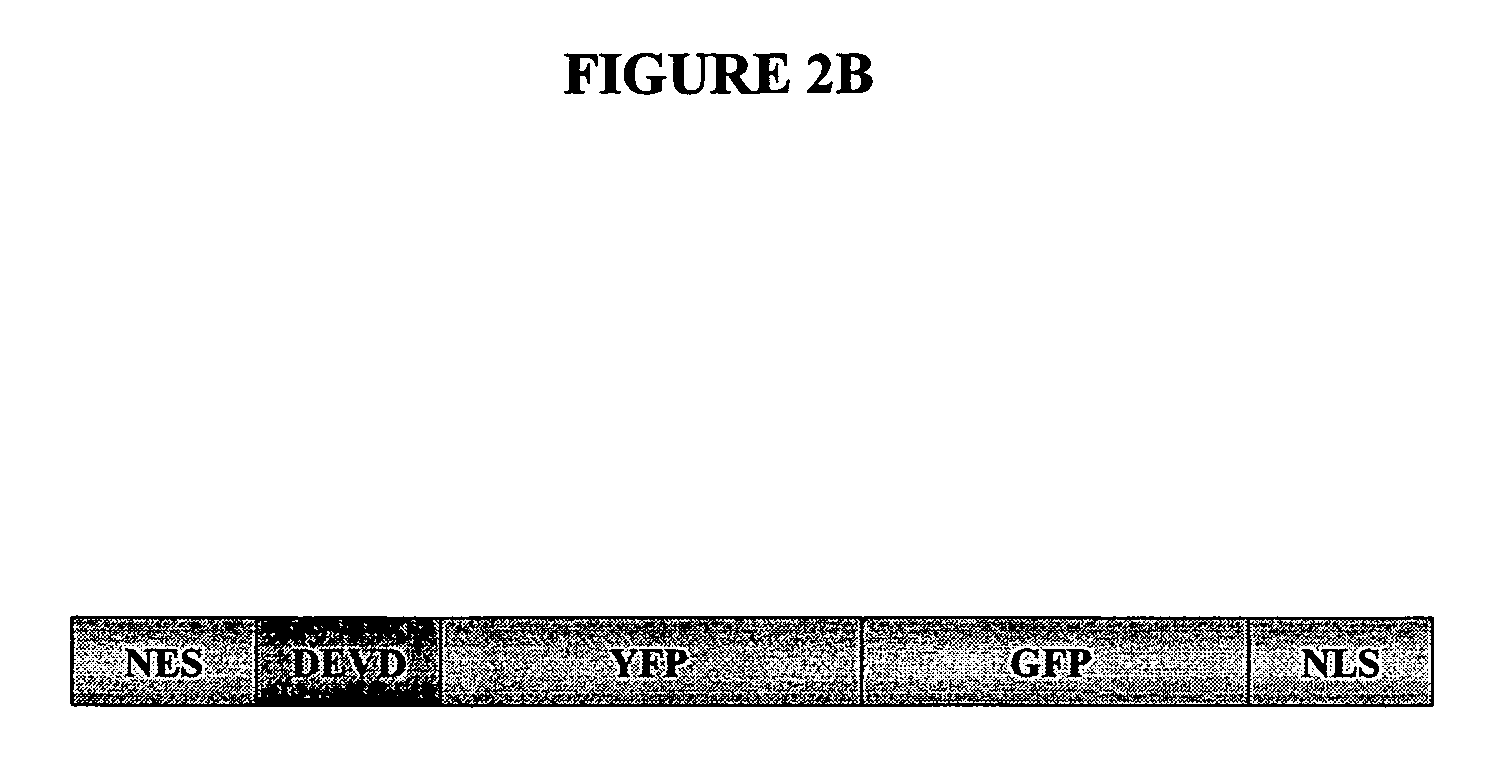Use of apotosis inhibiting compounds in degenerative neurological disorders
a technology of apotosis and inhibiting compounds, which is applied in the direction of animal repellents, drug compositions, ligases, etc., can solve the problems of invariably fatal outcome, low relief, and high risk associated with apotosis, so as to eliminate the need for immunosuppression, reduce the risk, and reduce the risk of side effects
- Summary
- Abstract
- Description
- Claims
- Application Information
AI Technical Summary
Benefits of technology
Problems solved by technology
Method used
Image
Examples
example 1
Methods and Materials
(i) XIAP Expression Plasmids
[0111]A full length human XIAP cDNA was amplified from U87-MG cells and cloned into pcDNA4. To produce pdXIAP, C-terminal 48 amino acid comprising the RING domain were removed in a second round of PCR. The integrity of all constructs was verified by sequencing.
(ii) Recombinant AAV Vectors
[0112]To generate AAV.dXIAP, the XIAP ORF lacking C-terminal 48 amino acid was PCR-amplified and cloned into an AAV expression plasmid (FIG. 1). It was engineered to contain the Kozak consensus translation start site. A control vector was generated by subcloning the EGFP cDNA into the same AAV backbone. Virus stocks were prepared by packaging the vector plasmids into AAV cerotype 2 particles using helper-free plasmid transfection system. The vectors were purified using heparin affinity chromatography and dialyzed against PBS. rAAV titers were determined by quantitative PCR using CMV-enhancer-specific primers and adjusted to 1012 genomic particles per ...
example 2
XIAP Protects SH-SY5Y Cells from 6-OHDA-Induced Apoptosis
[0118]This example describes how an inhibitor of apoptosis protein, XIAP, protects from 6-OHDA-induced apoptosis. SH-SY5Y cells were transfected with indicated plasmids, treated with 70 nM 6-OHDA and stained with propidium iodide. The results from the study are shown in FIG. 2A. Note a significant reduction of cell death by either XIAP or dXIAP compared to a control. All transfections were performed in triplicates. * p<0.001.
[0119]The location of apoptotic proteins was determined in an apoptosis assay using the pCaspase3-Sensor vector shown in FIG. 2B. The caspase-3 / 7 cleavage site appears in the DEVD region of the vector. The vector was transfected into cells and the results are shown in FIG. 2C. This fusion protein resides predominantly in the cytoplasm in normal cells (green). During apoptosis a nuclear exclusion signal (NES) at the N-terminus is cleaved by caspase-3 and the protein quickly translocates into the nucleus due...
example 3
XIAP is protective in In Vitro Models of Familial Parkinson's and Huntington's Diseases
[0121]This example describes how an inhibitor of apoptosis protein, XIAP, is protective in in vitro models of familial Parkinson's and Huntington's diseases. pAAV.GFP and pAAV.dXIAP were cotransfected into SH-SY5Y cells with pa-syn-RFP (FIG. 3A) or pQ111-RFP encoding for RFP fusions of the murine α-synuclein and the first exon of the mouse Huntington gene containing additional polyglutamine repeats, respectively. Apoptotic cells were scored 24 h post-transfection using YO-PRO-1 vital DNA dye (FIG. 3B). Note that live cells shown in the top panel (dashed arrow) are impermeable to YO-PRO-1 while cells undergoing apoptosis (solid arrow) are stained positive. * p<0.001. Phase contrast is shown in FIG. 3C. The percentage of cells undergoing apoptosis is shown in FIG. 3D.
[0122]These results demonstrate that dXIAP is a potent inhibitor of apoptosis in several in vitro models of Parkinson's disease includ...
PUM
| Property | Measurement | Unit |
|---|---|---|
| shrinkage | aaaaa | aaaaa |
| weight | aaaaa | aaaaa |
| length | aaaaa | aaaaa |
Abstract
Description
Claims
Application Information
 Login to View More
Login to View More - R&D
- Intellectual Property
- Life Sciences
- Materials
- Tech Scout
- Unparalleled Data Quality
- Higher Quality Content
- 60% Fewer Hallucinations
Browse by: Latest US Patents, China's latest patents, Technical Efficacy Thesaurus, Application Domain, Technology Topic, Popular Technical Reports.
© 2025 PatSnap. All rights reserved.Legal|Privacy policy|Modern Slavery Act Transparency Statement|Sitemap|About US| Contact US: help@patsnap.com



